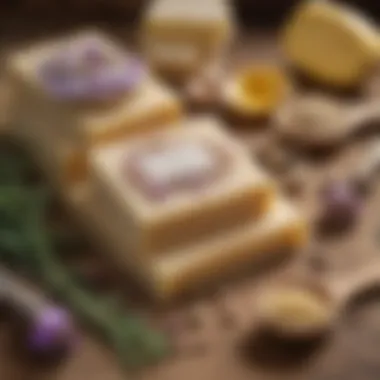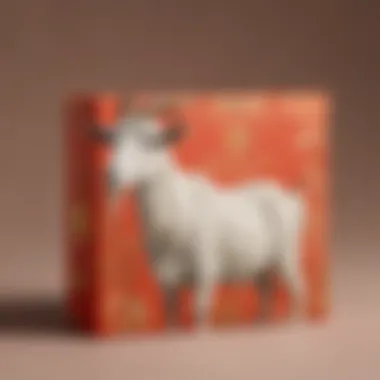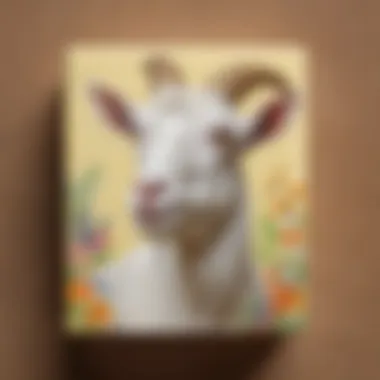The Ultimate Guide on Crafting Luxurious Goat Milk Soap at Home


Science Fun Facts
Did you know that soap has been made for thousands of years using different ingredients like animal fats and plant oils? Soap-making is a fascinating blend of art and science.
Discover the Wonders of Science
In the process of making goat soap, various scientific concepts come into play. For instance, understanding the chemical reactions between oils, lye, and water is crucial for successful soap-making.
Science Quiz Time
Interactive quizzes can test your knowledge on the properties of different oils used in soap-making. Multiple-choice questions can challenge your understanding of the saponification process.
Science Experiment Showcase
Creating goat soap involves following specific steps and safety precautions. Experimenting with different oils and fragrances can result in unique soap creations. Remember to always wear protective gear when handling lye.
Understanding Goat Soap
Goat soap is a unique and luxurious product that has gained popularity in the realm of skincare and self-care routines. Its significance lies in its rich history and the beneficial properties it offers. Understanding the intricacies of goat soap allows enthusiasts to appreciate its origins, benefits, and distinctive qualities that set it apart from conventional soaps. Exploring the world of goat soap provides a fascinating journey into the realm of natural, nourishing skincare.
What is Goat Soap?
Goat soap, as the name suggests, is soap made primarily from goat milk. Originating from ancient civilizations, the practice of incorporating goat milk into soap production has stood the test of time. The history of goat soap is deeply rooted in traditional soap-making methods, symbolizing purity and natural ingredients.
When considering the benefits of using goat milk in soap production, one cannot overlook its nourishing and moisturizing properties. Goat milk is rich in vitamins and minerals that are incredibly beneficial for the skin. Its gentle nature suits all skin types, especially sensitive skin prone to irritation. As a key ingredient in goat soap, goat milk adds a luxurious feel and hydrating touch that commercial soaps often lack.
Why Make Goat Soap?
Crafting goat soap presents a myriad of advantages over commercial varieties. Unlike mass-produced soaps loaded with synthetic ingredients, goat soap allows for a more personalized and wholesome skincare experience. The process of making goat soap enables individuals to tailor the ingredients to suit their preferences and address specific skin concerns.
Furthermore, the customization and personalization options in goat soap-making empower individuals to explore their creativity. From selecting essential oils for fragrance to choosing additional skin-loving ingredients, the versatility of making goat soap is unmatched. This level of customization ensures that each batch of goat soap is unique, reflecting the maker's preferences and priorities in skincare.
Getting Started


Goat soap making is an exciting and rewarding craft that offers a plethora of benefits for your skin. Before diving into the intricacies of the soap-making process, it is crucial to lay a solid foundation by getting started with gathering the necessary ingredients and equipment. This pivotal step sets the stage for a successful soap-making journey, ensuring that you have everything on hand to create your luxurious goat soap.
Gathering Ingredients and Equipment
Essential Oils
Essential oils, extracted from various plants, bring a myriad of benefits to goat soap. These oils not only impart natural fragrance but also offer therapeutic properties. The key characteristic of essential oils lies in their concentrated nature, requiring only a few drops to enrich your soap with captivating scents and potential skin benefits. Lavender, tea tree, and eucalyptus are popular choices for their calming, antiseptic, and refreshing qualities, respectively. However, essential oils may cause allergies in some individuals, so it is vital to conduct a patch test before widespread use.
Goat Milk and Other Ingredients
Goat milk serves as a fundamental component in goat soap due to its moisturizing and nourishing properties. Incorporating goat milk provides a creamy lather and gentle cleansing suitable for sensitive skin. Additionally, other ingredients such as shea butter, olive oil, and honey can further enhance the soap's skincare benefits. The uniqueness of goat milk lies in its rich content of vitamins and minerals that promote skin health. However, individuals with dairy allergies should exercise caution when using goat milk in soap-making.
Soap-Making Tools
Acquiring the right tools is essential for a seamless soap-making experience. Tools such as a digital scale, stainless steel pots, silicone molds, and stirring utensils are indispensable for precise measurements and safe handling of ingredients. The key characteristic of these tools is their durability and ease of cleaning, ensuring hygiene standards are met throughout the soap-making process. Whether measuring oils or mixing ingredients, having reliable tools at your disposal streamlines the craft and guarantees consistent results.
Safety Precautions
Protective Gear
Ensuring personal safety during soap-making is paramount, requiring the use of appropriate protective gear. Gloves, safety goggles, and long-sleeved clothing shield your skin and eyes from contact with caustic ingredients like lye. Protective gear not only minimizes the risk of accidents but also safeguards your skin from potential irritants. The key characteristic of protective gear is its ability to offer a physical barrier against harmful substances, prioritizing your well-being throughout the soap-making process.
Ventilation
Optimal ventilation is crucial when working with lye, a chemical compound central to soap-making. Adequate ventilation facilitates the dissipation of fumes, preventing respiratory irritation and ensuring a safe workspace. The key characteristic of proper ventilation lies in maintaining a well-aerated environment, free from stagnant fumes. By ventilating your soap-making area effectively, you create a comfortable and secure space to craft your goat soap with peace of mind.
The Soap-Making Process
In the grand scheme of crafting goat soap, the soap-making process emerges as the vital heartbeat, pulsating with significance and intricacies. This essential phase is where the magic unfolds, transforming raw ingredients into silky bars of bliss. Delving into the nuances of this process unveils a meticulous dance of precision and creativity.
Preparing the Ingredients
Measuring
Embarking on the journey of goat soap creation demands a keen eye for detail, especially when it comes to measuring. The art of precise measurement plays a fundamental role in ensuring the perfect balance of ingredients within every bar of soap. Each gram, each ounce carries the potential to elevate the final product to a realm of perfection. As we weigh and portion ingredients meticulously, the symphony of soap-making begins to harmonize.


Mixing
Once the ingredients are weighed to perfection, the act of mixing steps into the spotlight. Mixing, the gentle yet purposeful blending of elements, is where cohesion and uniformity take shape. This integration process is not merely about combining substances; it is about fusing scents, textures, and properties in a choreographed merger. The careful mixing sets the stage for the alchemical transformation that awaits in the subsequent stages.
Combining Ingredients
Melting the Base
In the alchemical symphony of goat soap fabrication, melting the base stands as a crucial movement. The base, in its solid state, harbors the promise of transmutation into a luscious liquid canvas. This melting process, akin to a delicate dance of heat and substance, coerces the base to shed its solidity and embrace fluidity. The base melts, yielding to the warmth of the process, preparing to intertwine with other essences.
Adding Goat Milk
Goat milk, the elixir of richness and nourishment, enriches the soap's essence through its addition. This step heralds the infusion of creamy goodness into the soap, imbuing properties of hydration and gentleness. The subtle aroma of goat milk wafts through the concoction, blending with other components in a tranquil unison. The addition of goat milk elevates the soap, rendering it not just a cleanser but a nurturing balm.
Incorporating Essential Oils
The incorporation of essential oils marks the zenith of olfactory artistry in goat soap production. Essential oils, with their potent fragrances and therapeutic benefits, infuse the soap with character and depth. Each drop of essential oil brings a kaleidoscope of scents, from calming lavender to invigorating citrus notes. The meticulous incorporation of essential oils is where the soap's personality unfurls, captivating users with a sensory symphony.
Molding and Curing
Pouring into Molds
The act of pouring the soap mixture into molds is akin to sculpting a masterpiece, albeit in liquid form. The liquid soap, like molten glass, flows into molds, taking shape and contours as it solidifies. The molds cradle the soap, imprinting each bar with its unique design and texture. As the soap settles into its mold, anticipation brews for the unveiling of individualized creations.
Allowing to Cure
Curing, the patient waiting game in the realm of soap-making, is where time performs its enchanting work. The freshly molded soap needs time to mature, to solidify its composition and character. During this period, the soap undergoes subtle transformations, enhancing its durability and quality. The silent process of curing culminates in bars of soap ready to embark on a cleansing journey.
Cutting and Packaging
Cutting into Bars
The decisive act of cutting the cured soap into bars unfolds like a ceremonial ritual. Each slice delineates a new beginning, separating the soap into individual units of pampering luxury. Precision is key as the blade meets the creamy surface, carving through to reveal the grainy interior. The cut bars exude a raw, unrefined charm, awaiting the final embellishment of packaging.
Packaging for Storage or Gifting


The art of packaging transcends mere containment; it is the final flourish that bestows elegance upon the soap bars. Whether destined for personal use or heartfelt gifting, the packaging is the first glimpse of the soap's allure. From simple wraps to ornate boxes, packaging preserves the soap's essence while enhancing its aesthetic appeal. The well-packaged soap awaits its moment of glory, poised to grace bathrooms or bring joy as heartfelt presents.
Troubleshooting and Tips:
Troubleshooting and Tips play a pivotal role in this comprehensive guide for crafting homemade goat soap. Within the world of soap-making, encountering challenges and learning how to troubleshoot them is essential for producing high-quality soaps consistently. The section provides valuable insights into addressing common issues and expert tips that can elevate your goat soap-making experience.
Common Issues:
Seizing:
Seizing is a common issue that soap-makers may face during the saponification process. It occurs when the soap mixture thickens unexpectedly and becomes difficult to work with. Despite being a frustrating occurrence, Seizing can lead to unique textured soap designs and patterns. In this article, the characteristics of Seizing are explored in detail, highlighting how this phenomenon can be controlled and even used to an advantage in creating visually appealing soaps.
Acceleration:
Acceleration refers to the rapid increase in soap mixture viscosity, making it challenging to work with. While Acceleration can be problematic for intricate designs, it also provides a benefit by speeding up the soap-making process. This article dives into the consequences of Acceleration in soap-making, offering insights on how to work with this phenomenon effectively to enhance productivity.
Expert Tips:
Scent Combinations:
Scent combinations are a crucial aspect of creating unique and captivating goat soaps. The right blend of essential oils can evoke emotions and elevate the sensory experience of using the soap. This section delves into the art of scent combinations, emphasizing how carefully curated aromas can set your goat soap apart. Discover the science behind scent combinations and learn how to experiment with different fragrances to craft exquisite soaps.
Texture Adjustments:
Texture adjustments are fundamental in achieving the desired consistency and feel of goat soap. Whether aiming for a creamy lather or a gentle exfoliating bar, understanding how to make texture adjustments is key. This article guides you through the process of tweaking soap textures, exploring the advantages and potential challenges of such modifications. Mastering texture adjustments empowers you to customize your goat soap formulations to suit your preferences perfectly.
Conclusion
The Conclusion section of this article serves as the pinnacle of knowledge assimilation for all aspiring goat soap artisans. Understanding the key takeaways is vital for those embarking on their homemade soap-making journey. Reflecting on the journey from ingredient selection to the final exquisite goat soap bars is imperative for personal growth and skill enhancement. Embracing the amalgamation of artistry and science that soap-making entails is a cornerstone of mastering this craft. Seizing the opportunity to enjoy the fruits of one's labor and hone their skills is a rewarding experience unrivaled. Thus, the Conclusion encapsulates not merely the end but the commencement of a continuous learning process in the world of goat soap creation.
Enjoy Your Homemade Goat Soap!
When delving into the realm of homemade soap, one cannot overlook the inherent benefits of handmade creations. The meticulous effort and care poured into each bar bear fruit in the form of unparalleled quality and personalized touch. Handmade soap stands out due to its unique composition free from harmful additives often found in mass-produced alternatives. The advantages of using such soap extend beyond mere cleansing; they nourish the skin and elevate the bathing experience. Experimentation with diverse ingredients opens the door to endless possibilities, allowing for tailored solutions to individual skincare needs. The adaptability inherent in handmade soap empowers users to cater to specific preferences, promoting a healthier and more gratifying self-care routine.
Benefits of Handmade Soap
Discussing the benefits of handmade soap is elemental in comprehending its significance within the soap-making domain. The exclusive nature of handmade soap lies in its customizability and purity that revitalizes the skin. Not only does it cleanse effectively, but it also nurtures the skin with natural ingredients devoid of harsh chemicals. The distinctive feature of handmade soap lies in its artisanal creation process, ensuring a superior product compared to mainstream options. Its advantageous aspects encompass enhanced moisturization, gentle exfoliation, and long-lasting fragrance, making it a popular choice for those seeking a premium bathing experience. Despite its luxurious appeal, handmade soap remains an eco-friendly alternative, aligning with sustainable living practices for conscientious consumers.
Experimentation and Improvement
Exploring the realm of experimentation and improvement heightens one's abilities in soap making. By embracing novel techniques and ingredients, artisans can refine their craft and discover innovative formulations that cater to diverse preferences. The key characteristic of experimentation lies in its capacity to foster creativity and innovation, transforming soap-making into a dynamic and fulfilling pursuit. Through continuous improvement, artists can enhance not only the aesthetic appeal but also the efficacy of their creations. The unique feature of experimentation lies in its ability to inspire new trends and push the boundaries of traditional soap-making methods. While experimentation presents the challenge of perfection, it propels artisans towards excellence, promoting growth and mastery in this art form.





